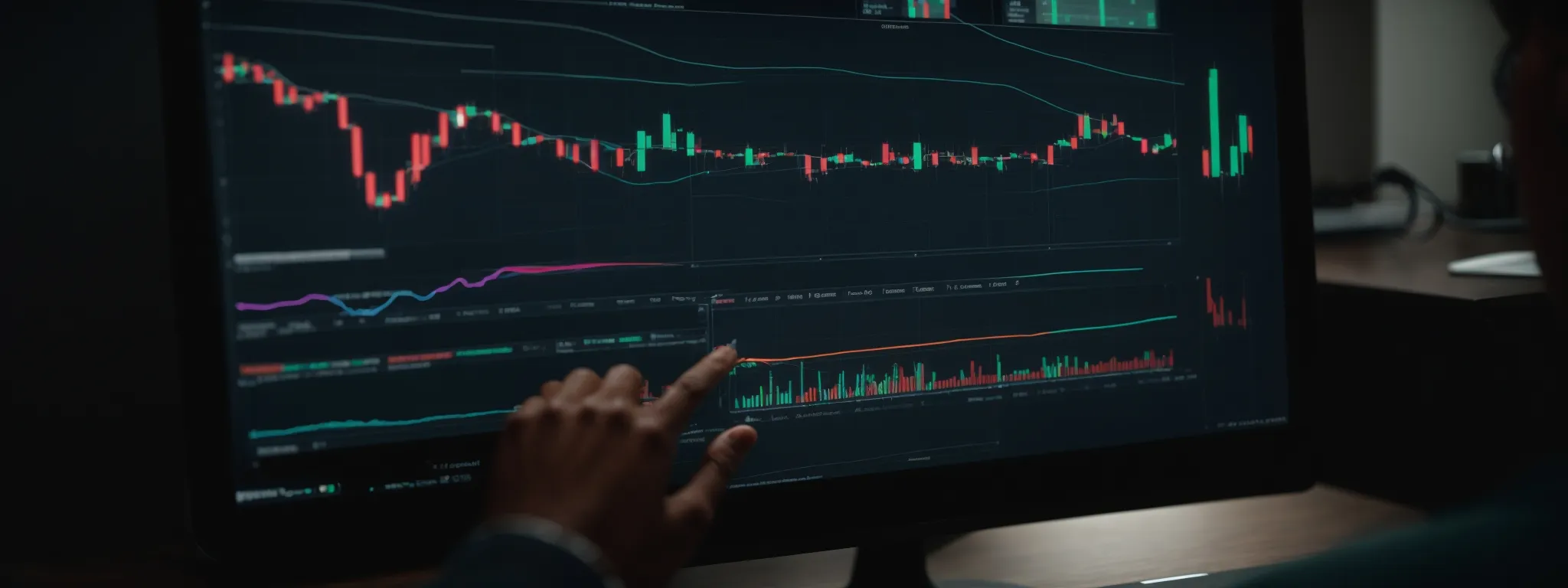Forecasting SEO Trends with Python
Forecasting SEO Trends With Python Navigating the ever-evolving landscape of search engine optimization demands a proactive approach, particularly in harnessing the predictive power of data science. With […]
Forecasting SEO Trends With Python
Navigating the ever-evolving landscape of search engine optimization demands a proactive approach, particularly in harnessing the predictive power of data science.
With the integration of Python, professionals can extrapolate search trends, refine marketing strategies, and enhance their SEO ROI with unprecedented precision.
This article unfolds the potential of Python in SEO trend forecasting, guiding search strategists through the advanced techniques of gathering, analyzing, and visualizing data for actionable insights.
From understanding seasonality in search queries to anticipating algorithmic shifts, the seamless synergy of Python with SEO tasks sets a new paradigm.
Keep reading to unlock the competitive edge in your SEO efforts through the science of forecast modeling.
Key Takeaways
- SEO Forecasting With Data Science and Machine Learning Enhances Strategic Planning and Increases ROI
- LinkGraph’s SEO Services Leverage Predictive Models and Python Libraries to Inform Robust SEO Strategies
- Integrating SEO Trend Forecasting Into Marketing Efforts Allows Businesses to Preemptively Adjust to Search Demands
- Visualization Tools Within Python Provide LinkGraph Clients With Clear Insights for Informed, Data-Driven Decision-Making
- Python’s Role in Technical SEO and Deep Learning Offers LinkGraph a Competitive Edge in Predicting and Adapting to Search Trends
Understanding the Basics of SEO Trend Forecasting

Amidst an online landscape saturated with competition, businesses stand to gain considerably by anticipating the ebb and flow of search engine dynamics.
Search Engine Optimization (SEO) forecasting emerges as a cutting-edge approach, pairing the predictive prowess of data analysis with advanced programming tools like Python.
This foresight empowers entities to align their digital presence with the nuanced demands of search algorithms and user behavior patterns.
As companies integrate SEO forecasting into their marketing strategy, they not only traverse the digital terrain with enhanced precision but also capitalize on the invaluable opportunity to optimize resources and bolster their return on investment.
Defining SEO Forecasting in a Data-Driven Era
SEO forecasting stands as a formidable integration of data science and search engine expertise, where Predictive Models Like SARIMAX and machine learning are deployed to forecast search trends and website traffic. This analytical process utilizes historic keyword data, competitor traffic insights, and Google trends data to inform a company’s forward-looking SEO strategy.
LinkGraph harnesses the power of their distinctive SearchAtlas SEO software, Injecting Scientific Accuracy Into SEO Work. Clients benefit from a tailored SEO forecast that informs future content strategies, marketing campaigns, and helps to prioritize SEO tasks, ensuring each action is data-backed and targeted for maximal organic search impact.
The Role Python Plays in Predicting SEO Outcomes
In the realm of SEO trend forecasting, Python stands out as an indispensable tool for data scientists and SEO analysts. Its libraries, such as NumPy for numerical data processing, and Pandas for data manipulation, enable the handling of voluminous datasets with agility.
Utilizing Python, specialists are capable of scripting sophisticated algorithms that process historical keyword performance and search demand to project future search trends. This empowers SEO managers and strategists to craft data-driven approaches to optimizing web page visibility and conversion rates.
| Forecasting Component | Function | Python Library |
|---|---|---|
| Data Collection | Gathering Historical Data | Pandas |
| Data Analysis | Identifying Patterns | NumPy |
| Algorithm Development | Creating Predictive Models | SciPy |
| Visualization | Representing Data Graphically | Matplotlib |
| Machine Learning | Automating Prediction Tasks | scikit-learn |
Key Benefits of SEO Forecasting for Businesses
Businesses that invest in SEO forecasting position themselves to reap a host of competitive advantages. The anticipation of SEO trends affords them the capability to pre-emptively fine-tune their marketing efforts, ensuring that resource allocation toward SEO work is both strategic and conformant with projected search demands, potentially improving search rankings and website traffic ahead of market shifts.
Through the strategic application of SEO forecasts, companies can witness substantial improvements in their search engine visibility and user engagement metrics, such as click-through rates (CTR). SEO forecasting’s predictive insights enable businesses to target content more effectively to user searches, lifting organic search performance, and enhancing overall SEO return on investment (ROI).
Gathering SEO Data With Python for Analysis

The intricacies of forecasting SEO trends demand a robust framework for data collection and analysis.
Python, renowned for its versatility in programming, facilitates the meticulous process of retrieving vast quantities of SEO data.
Digital marketers and SEO professionals leverage Python’s capabilities to scrape Search Engine Results Pages (SERP) for valuable insights.
APIs provided by leading SEO tools become instrumental in this endeavor, simplifying the otherwise complex task of data retrieval.
Furthermore, Python’s extensive libraries assist in scrubbing, organizing, and preparing datasets, setting the stage for rigorous analysis that underpins a preemptive and strategic SEO approach.
Using Python to Scrape Search Engine Results Pages
Python’s prowess extends to the extraction of vital data from Search Engine Results Pages (SERPs), a process essential for Refining SEO Strategies. By deploying Python scripts, LinkGraph’s SEO experts efficiently harvest search result information that is key to understanding the current landscape of target keywords and competitor presence.
The data gleaned from SERPs through Python aids LinkGraph in tailoring a sophisticated SEO content strategy, one designed to elevate a client’s digital footprint by focusing on user-centered content that aligns with trending search queries. This meticulous approach ensures that SEO efforts are rooted in actionable data, fostering informed decisions for enhancing online visibility.
Leveraging APIs for Data Retrieval From SEO Tools
Leveraging APIs for enriched SEO data retrieval marks a modern frontier in search engine optimization strategy. LinkGraph expertly employs such technological pathways to access a wealth of information critical for developing robust SEO analyses and predictive strategies.
| Data Aspect | API Usage | Benefits |
|---|---|---|
| Keyword Performance | Extraction of search volume and trends | Enables targeted content creation |
| Competitor Analysis | Monitoring competitor domain strength | Facilitates strategic positioning |
| Backlink Profile | Assessment of link quality and quantity | Guides white-label link building efforts |
| Local SEO Metrics | Insights into geographically relevant data | Optimizes local SEO services |
This integration of API technology streamlines the SEO process by granting direct access to machine-readable datasets, bypassing the need for manual data compilation. Through the strategic application of these tools, LinkGraph furnishes clients with intricate, data-driven insights to amplify their SEO performance and ultimate digital success.
Cleaning and Preparing Datasets for Analysis
Cleansing the gathered SEO data is a pivotal step that LinkGraph’s specialists perform with a meticulous eye for detail. They employ Python’s comprehensive data handling libraries to detect and amend discrepancies, ensuring the datasets’ integrity is pristine for high-quality analysis.
Once the data is purified, LinkGraph’s experts proceed to structure and segment it into coherent subsets, allowing for a refined analysis. This preparation is essential in building a reliable foundation for predictive models that inform the clients’ SEO strategies.
Building an SEO Forecasting Model With Python

The science of forecasting SEO trends demands a sophisticated technological approach, one that harnesses the strengths of select Python libraries to craft predictive models with unrivaled accuracy.
As developers and SEO professionals embark on building these models, they pour over historical data, delineating the patterns and anomalies that drive search engine results.
By integrating refined machine learning algorithms into these models, they enhance the precision of their predictions, enabling businesses to navigate the SEO landscape with greater confidence and strategic acumen.
Selecting the Right Python Libraries for SEO Forecasting
Selecting the right Python libraries is a critical decision that influences the efficacy of an SEO forecasting model. Prospective tools must offer robust capabilities for handling time series data, as seen with libraries like Pandas for data manipulation and Matplotlib for data visualization, which are indispensable for parsing trends and seasonality in search demand.
LinkGraph’s Methodical Approach entails choosing libraries that support the development of machine learning models, such as scikit-learn, which provides an array of algorithms for making educated predictions on search traffic and keyword performance. This careful curation of Python tools ensures that their SEO forecasting models are both agile and accurate, offering clients a cutting-edge advantage in the relentless pursuit of SEO excellence.
Training a Model on Historical SEO Data
The significance of historical SEO data as the bedrock of predictive modeling cannot be overstated. By meticulously training a forecast model on a foundation of past SEO data, LinkGraph equips the model with the ability to discern patterns and insights that are likely to reemerge or evolve.
| Data Consideration | Process Involved | Outcome for SEO Forecasting |
|---|---|---|
| Keyword Performance Tracking | Analyzing historical search volume and ranking data | Predicting future keyword trends and opportunities |
| Competitor Benchmarking | Examination of competitor SEO strategies and results over time | Anticipating competitor moves and adjusting tactics accordingly |
| Search Trend Analysis | Assessing search demand seasonality and changes | Adapting content strategy to capitalize on predictable search surges |
Furthermore, this training period is crucial for refining the SEO forecasting model, ensuring it embodies a high level of predictive accuracy for both search volume and traffic data. LinkGraph’s approach, applying advanced machine learning techniques to this historical data, provides a robust framework through which the client’s SEO strategy can be both validated and optimized for future success.
Integrating Machine Learning Algorithms for Precision
For LinkGraph, the confluence of machine learning algorithms with SEO forecasting isn’t just a procedure; it’s a transformation of data into a strategic asset. Their team employs sophisticated machine learning models that intricately analyze patterns and anomalies from large datasets, translating them into precise predictions that underpin competitive SEO strategies.
This precision translates into actionable insights, such as identifying which content will resonate with users or optimizing a webpage for increased conversions. By integrating these advanced algorithms, LinkGraph ensures that their clients can anticipate and respond to SEO trends with unparalleled accuracy.
| Machine Learning Phase | Purpose | Outcome for SEO |
|---|---|---|
| Pattern Recognition | Analyze historic and competitor data | Uncover actionable trends and content gaps |
| Algorithm Training | Equip model with historical insights | Enhance forecast accuracy for keyword performance |
| Model Validation | Test predictions against actual outcomes | Refine SEO approach for greater ROI |
| Forecast Implementation | Apply predictions to strategic planning | Adapt marketing campaigns to future search behaviors |
Visualizing SEO Data for Better Insights

In the endeavor to demystify SEO data and its future implications, visualization emerges as an indispensable aspect of any thorough analytical process, proffering tangible insights into the otherwise abstract numerical realm.
As part of LinkGraph’s comprehensive suite of SEO forecasting capabilities, Python’s plotting libraries are adeptly employed to sculpt interactive representations that illuminate forecasted SEO trends, allowing businesses to grasp complex data through intuitive visual charts.
This critical phase harnesses the detail within datasets to chart a path forward, making granular SEO patterns accessible and operational for strategic decision-making.
Crafting Visual Representations of Forecasted SEO Trends
LinkGraph showcases an innate proficiency in Transforming SEO Predictive Analytics into comprehensive visual narratives. Their use of Python’s data visualization tools, such as Matplotlib and Seaborn, gives clients an easily digestible view of complex data, enabling quick interpretation of forecasted SEO trends and facilitating strategic planning.
The visualizations offer a vivid roadmap of potential market shifts, allowing businesses to adjust their SEO efforts in alignment with future search behaviors. These graphic depictions serve not merely as illustrations but as strategic blueprints that reveal the intersection of user interests, seasonal search patterns, and anticipated content relevancy.
Utilizing Python’s Plotting Libraries for Interactive Charts
LinkGraph’s incorporation of Python’s plotting libraries like Matplotlib and Seaborn transforms raw data into interactive charts that bring SEO forecasts to life. These tools facilitate the creation of dynamic graphs and visualizations that effectively communicate potential shifts in search trends, enabling clients to make informed decisions swiftly.
Interactivity, made possible through Python’s advanced libraries, allows LinkGraph’s clients to explore different facets of their SEO data in real-time. This hands-on visual approach aids in uncovering hidden insights within their search engine data, crafting a visual dialogue between the SEO strategy and the numeric story the data tells.
Implementing Time Series Analysis for SEO Forecasting

The art of predicting the trajectory of SEO hinges on the interpretation of time series data—a chronologically ordered set of points that represent how key metrics evolve over time.
Time series analysis stands at the forefront of SEO forecasting, providing a statistical backbone to the intricate process.
Implementing this analysis requires a confluence of understanding time series fundamentals, applying statistical models such as ARIMA within Python, and unwrapping the layers of seasonality and trend components inherent in SEO data.
This rigor allows practitioners to distinguish between short-term fluctuations and enduring shifts, equipping businesses with strategic foresight into the search patterns that will shape their domain’s future.
Understanding the Principles of Time Series Forecasting
Grasping the principles of time series forecasting is essential for those endeavoring to predict SEO trends competently. A time series is a sequence of data points indexed in time order—an intrinsic component for analyzing behavioral trends over set intervals, which can delineate cyclical patterns, outlier events, or directional shifts in search data.
Time series analysis operates at the core of SEO forecasting, employing statistical techniques that discern and quantify the patterns observed in data over time. This analytical approach directly informs the construction of predictive models, facilitating an understanding of potential future SEO trends and allowing businesses to make data-driven decisions in their strategies.
Applying ARIMA Models in Python for SEO Predictions
LinkGraph’s predictive capabilities extend to the adept use of ARIMA models within Python to deliver precise SEO projections. Through the active application of the Autoregressive Integrated Moving Average model, they effectively capture and analyze the temporal dynamics of search data, uncovering trends that refine the strategic direction of SEO campaigns.
Deploying ARIMA models enables LinkGraph’s data scientists to quantify the relationship between past search query performance and future predictions, thus providing clients with actionable insights for optimizing web pages. Such model application ensures that their SEO roadmap is bolstered by statistically sound forecast mechanisms, driving informed decision-making for enhanced online visibility.
Seasonality and Trend Decomposition in SEO Data
Within the intricate discipline of SEO forecasting, understanding the interplay between seasonality and trends in data is paramount. LinkGraph deftly navigates through seasonal variations to elucidate underlying trends, employing advanced decomposition techniques that separate recurrent seasonal patterns from the long-range directions in search query data.
By isolating these components, LinkGraph provides clients with a clear perspective on how time-specific events and general search behavior evolve. This meticulous differentiation is instrumental in crafting an SEO strategy that adeptly leverages seasonal peaks and accommodates for the long-term trajectory of organic search interest.
Utilizing Natural Language Processing for SEO Insights

In the rapidly evolving sphere of search engine optimization, harnessing the power of Natural Language Processing (NLP) marks a pivotal advancement for discerning the intricacies of search query trends.
With an arsenal of NLP techniques, experts at LinkGraph delve into the depths of linguistic patterns and semantical structures inherent within search data.
This analytical pursuit, powered by Python’s computational might, unveils emerging keywords and topics, equipping SEO strategists with the foresight to not only react to the current market but to proactively shape their content in anticipation of the next digital zeitgeist.
Analyzing Search Query Trends With NLP Techniques
LinkGraph expertly applies Natural Language Processing (NLP) to decipher the subtleties of search query trends, ensuring their clients’ content is precisely aligned with the evolving language patterns of users. This application of NLP techniques reveals the nuances in queries that can make the difference between a website that resonates with its audience and one that does not.
Through the analysis of linguistic structures and search term relevancy, LinkGraph’s team crafts a content strategy that not only responds to current user intent but also anticipates future linguistic shifts. Their skillful use of NLP positions clients to lead rather than follow in the dynamic world of SEO, ensuring sustained visibility across search engines.
Identifying Emerging Keywords and Topics With Python
In the arsenal of technical SEO, Python emerges as a formidable tool for pinpointing trending keywords and topics, crucial for a forward-thinking SEO content strategy. It scans through massive datasets, applying natural language processing (NLP) to detect subtle shifts and emerging patterns in user search behavior.
- Using Python-based NLP to parse search query data.
- Discovering linguistic trends indicating new keyword opportunities.
- Deploying algorithms to project topical relevance and interest.
LinkGraph enriches its SEO services by integrating Python’s computational capabilities to unveil pivotal insights. This proactive stance on keyword discovery empowers clients to capture emerging market segments and fortify their presence on the search engine results pages.
Integrating Python With Google Analytics for Advanced Analysis

Within the realm of search engine optimization, the synthesis of Google Analytics data with Python scripting unlocks a higher level of precision in SEO trend forecasting.
Keen on leveraging the breadth of user interactions and performance metrics Google Analytics provides, SEO experts at LinkGraph interlace this rich stream of data with advanced analytical models.
From delving into user engagement metrics to refining a website’s conversion tactics, Python’s role in accessing and extracting actionable insights from Google Analytics paves the way for data-driven SEO forecasting excellence.
Such integration enables the creation of sophisticated forecast models informed by direct, live-data feedback, heralding a new pinnacle in strategic marketing fortitude.
Accessing and Extracting Google Analytics Data With Python
The fusion of Python’s scripting might with Google Analytics data epitomizes advanced SEO analysis, allowing experts at LinkGraph to distill complex user interaction data into actionable insights. This seamless integration facilitates access to a reservoir of data points, which, when processed, yield a rich tapestry of user behavior, engagement metrics, and conversion statistics pivotal for shaping SEO strategies.
By harnessing Python’s ability to automate data extraction from Google Analytics, LinkGraph lays the foundation for nuanced SEO forecasting models that capitalize on real-time data. The agility with which Python scripts navigate and siphon this data reinforces the precision of SEO projections, allowing clients to adapt their strategies swiftly in response to emerging user trends and website performance metrics.
Combining Google Analytics Insights With SEO Forecast Models
LinkGraph’s integration of Python with Google Analytics revolutionizes the potential behind SEO forecast models. By synthesizing on-site user behavior metrics with off-site traffic predictions, the resultant models afford businesses a composite view of their digital footprint’s future.
The confluence of Google Analytics insights and SEO forecast models delivers a nuanced perspective on prospective user engagement and conversion paths. LinkGraph, through meticulous data curation, ensures that each model reflects an intelligent response to historical trends and real-time analytics.
Predicting the Impact of Algorithm Updates on SEO

Adjusting to the ever-evolving landscape of search engines necessitates an acute awareness of changes that algorithm updates induce.
As these updates can significantly shift user search patterns, businesses must quickly quantify and adapt to these changes to maintain a competent SEO stance.
Professionals employ Python’s analytical capabilities to revise SEO forecast models, integrating these new variables and ensuring that SEO strategies remain both resilient and responsive in the face of algorithmic shifts.
Thus, navigating algorithm updates with agility becomes an essential component in the ongoing quest for enduring online relevance and success.
Quantifying Changes in Search Patterns Post-Algorithm Update
In the milieu of SEO, algorithm updates are critical game-changers, catalyzing immediate shifts in search patterns and demanding rapid response from businesses. LinkGraph’s experts utilize Python’s data analysis capabilities to measure these fluctuations, enabling quantification of the precise impact stemming from algorithmic changes.
Armed with this knowledge, LinkGraph crafts SEO strategies that reflect the newest search engine criteria:
- Assessment of algorithm update ramifications on existing SEO performance.
- Swift adaptation of SEO tactics to align with updated search engine protocols.
- Continuous monitoring to gauge long-term effects of algorithm changes on search behavior.
The agility to adapt to algorithmic fluctuations not only preserves but also enhances a website’s search relevancy. This proactive stance ensures LinkGraph’s clients maintain a decisive edge in an ever-shifting SEO landscape.
Modifying the SEO Forecast Model to Adapt to New Variables
In an era where search engine algorithms are continually evolving, LinkGraph’s commitment to refining their SEO forecast models is paramount. By proactively modifying these models, the firm ensures they account for new algorithmic variables, keeping their clients’ SEO strategies ahead of the curve and aligned with the latest search engine guidelines.
Adaptation is key, and LinkGraph’s specialists demonstrate this by regularly updating their machine learning models to reflect the latest search engine updates. This nimble approach to model modification safeguards clients’ SEO performance, enabling them to maintain a robust online presence amidst a landscape of constant digital change.
Advancing SEO Forecasting With Deep Learning

In the domain of search engine optimization, the expansion into deep learning signifies a monumental leap in the predictive capabilities harnessed by SEO professionals.
LinkGraph, at the vanguard of these advancements, leverages deep learning’s substantial aptitude for unraveling complex patterns that traditional algorithms might overlook.
The construction of neural networks using Python equips LinkGraph with the instrumental ability to generate advanced forecasts, providing clients a profound edge in the unfolding narrative of search trends.
With deep learning, the firm is poised to distill an unprecedented depth of SEO insights, steering strategic planning with superior precision and acumen.
Introduction to Deep Learning for Complex Pattern Recognition
LinkGraph embarks on harnessing deep learning to navigate the multifaceted patterns in search engine behavior, transcending conventional analytics. Their experts utilize Python’s computational framework to construct neural networks, enabling a leap in pattern recognition beyond the grasp of traditional SEO tools. This approach unveils intricate correlations in large-scale data, sharpening the precision of SEO strategies.
The firm’s deep learning application is pivotal in identifying latent variables within searches that classical models may not detect. By dissecting and interpreting these complex patterns, LinkGraph’s forecasting models deliver a nuanced understanding of search trends, ensuring their clients’ proactive rather than reactive adaptation to the ever-changing algorithms of search engines.
Constructing Neural Networks With Python for Advanced Forecasts
LinkGraph’s adoption of neural network construction using Python signals a transformative shift in the landscape of SEO forecasting. By developing deep learning models, the company poises itself to capture the subtleties of search engine behaviors, offering an advanced level of foresight and precision in predicting SEO trends.
The crafting of neural networks through Python empowers LinkGraph to uncover nuanced patterns and anticipate changes within the SEO ecosystem. This predictive modelling framework stands to revolutionize client strategies, providing a robust competitive edge in the intricate dance of search engine rankings and user engagement.
- Deep learning models push the boundaries of forecast precision.
- LinkGraph empowers clients with sophisticated trend anticipation techniques.
- Neural networks identify and exploit intricate search engine patterns.
- Python becomes the tool driving cutting-edge SEO strategy formulation.
Conclusion
Forecasting SEO trends using Python offers businesses a significant strategic advantage by allowing them to anticipate and adapt to the ever-changing landscape of search engine algorithms.
Python’s powerful data analysis and machine learning libraries enable SEO experts to create predictive models based on historical data, providing insights into future search behaviors and keyword performance.
This level of foresight enhances marketing strategies, optimizes resource allocation, and maximizes ROI.
Furthermore, the integration of NLP and deep learning uncovers emerging trends and refines content strategies, while Google Analytics data provides a comprehensive view of user engagement, all fueling a responsive and resilient approach to SEO.
By staying ahead of the curve with Python-powered SEO forecasting, businesses can maintain a competitive edge in the digital marketplace.














































































